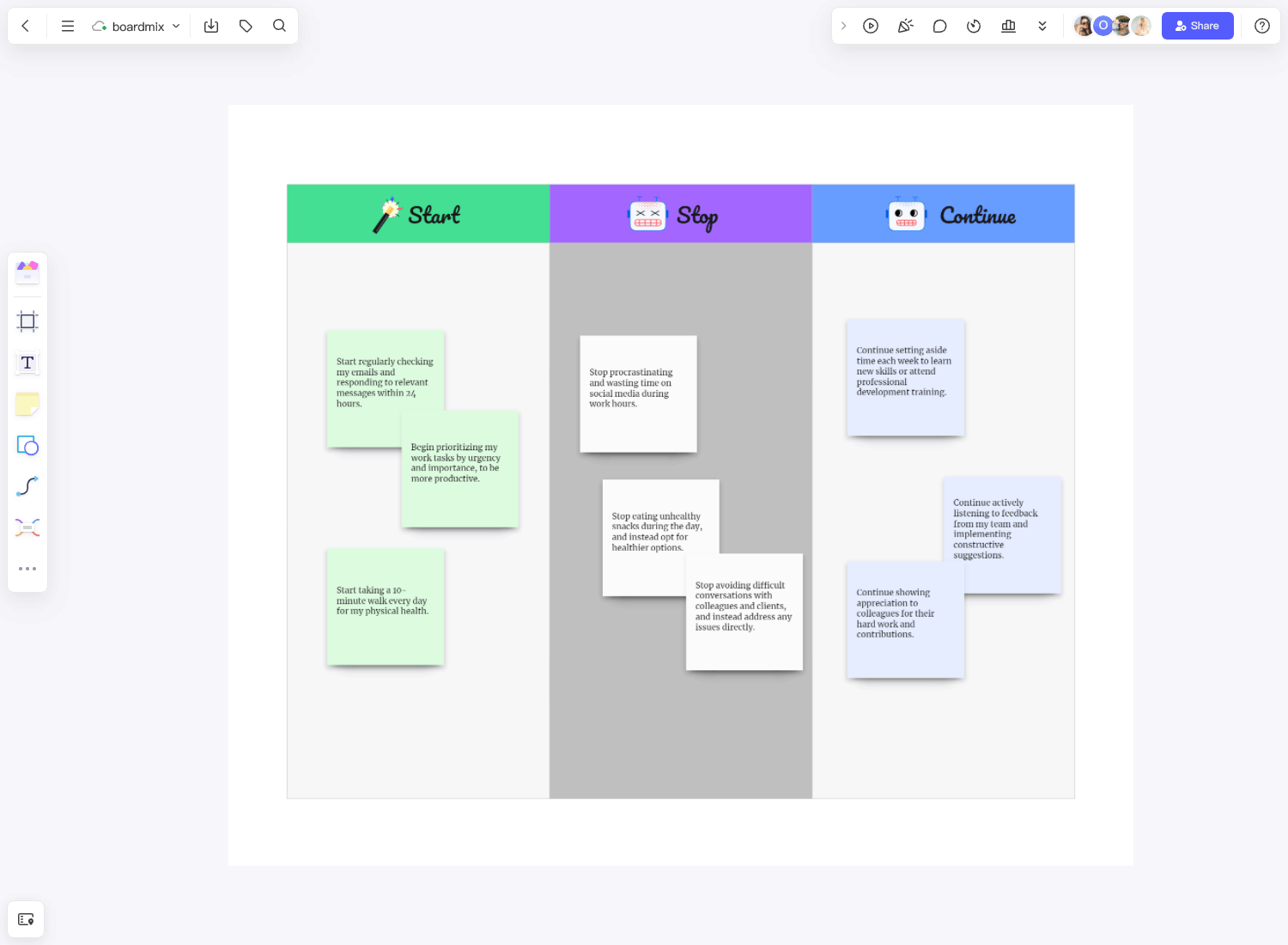There is always room for improvement at work, whether in the progress rate of an ongoing project or a company's sales performance for the last quarter. The start stop continue template is useful to identify these areas and effect the needed changes.
What is Start Stop Continue?
Start stop continue is a simple but effective evaluation tool based on answering three fundamental questions. What actions have you not been doing but might be good to start? What actions have not been very helpful and are better to stop? What actions have shown positive results and so must be continued?

Build Start Stop Continue for Free
The answers to these questions are listed in three columns start, stop, and continue. But more than just making a list, this method encourages each team member to reflect on their past activities as an individual part of the team. Likewise, it encourages everyone to provide feedback on collaborative team actions.
Why Use the Start Stop Continue Template?
The start stop continue template offers numerous benefits for any group hoping to achieve a goal and is a simple yet powerful tool for personal development and process improvement.
Clearer Goals: By identifying what needs to start, stop, or continue, individuals or teams can set clearer goals for themselves. It provides direction and focus, enhancing productivity.
Improved Self-Awareness: The template encourages individuals to reflect on their actions and behaviors, increasing self-awareness. This can lead to better decision-making and improved performance both at work and in personal life.
Enhanced Communication: In a team setting, this tool can facilitate open and constructive feedback among team members. It promotes a culture of transparency and continuous learning.
Identification of Inefficiencies: The "Stop" aspect of the template helps identify practices that are not productive or beneficial. Eliminating these can lead to more efficient use of resources.
Encourages Continuous Improvement: The "Continue" component encourages recognition of practices that are working well. This positive reinforcement can motivate individuals or teams to maintain good practices and strive for continuous improvement.
The start stop continue template also encourages team members to think creatively about new things that could improve the group's performance and contribute significantly to achieving the team's goals.
When to Use the Start Stop Continue Template?
There are many situations where the start stop continue template would be very useful for an organization. It can be used for evaluating a product, analyzing the market, optimizing business finances, and so on. But while organizations most often use it to evaluate team performance and boost overall work productivity, there are also other applications of the start stop continue template, and not all of them are necessarily in the workplace.
Project Management: In project management, the template can be used at different stages of a project (like after completing a phase or at the end of the project) to evaluate what worked well, what didn't work well, and what needs to be changed for future projects.
Performance Reviews: This template is an excellent tool for providing structured feedback during performance reviews. It identifies what an employee should start doing, stop doing, and continue doing to improve their performance.
Personal Development: On a personal level, you can use this template for self-reflection and goal setting. It helps you identify your strengths, areas of improvement, and actions you need to take to achieve your goals.
Team Meetings: During team meetings, the template can be used to facilitate discussions about team performance, project progress, or process improvement. It encourages open communication and continuous learning within the team.
Additionally, the start stop continue technique is also used by many teachers to encourage the well-rounded development of young students. Using the same format used by team leaders and project managers, kindergarteners can also think of actions they want to start, stop, and continue.
Examples of Effective Use of the Start, Stop, Continue Template
The Start, Stop, Continue template is a powerful tool that can be utilized in various aspects of business and personal life. Let's delve into some examples to illustrate its effective use.
Streamline Decision-Making Start Stop Continue Template
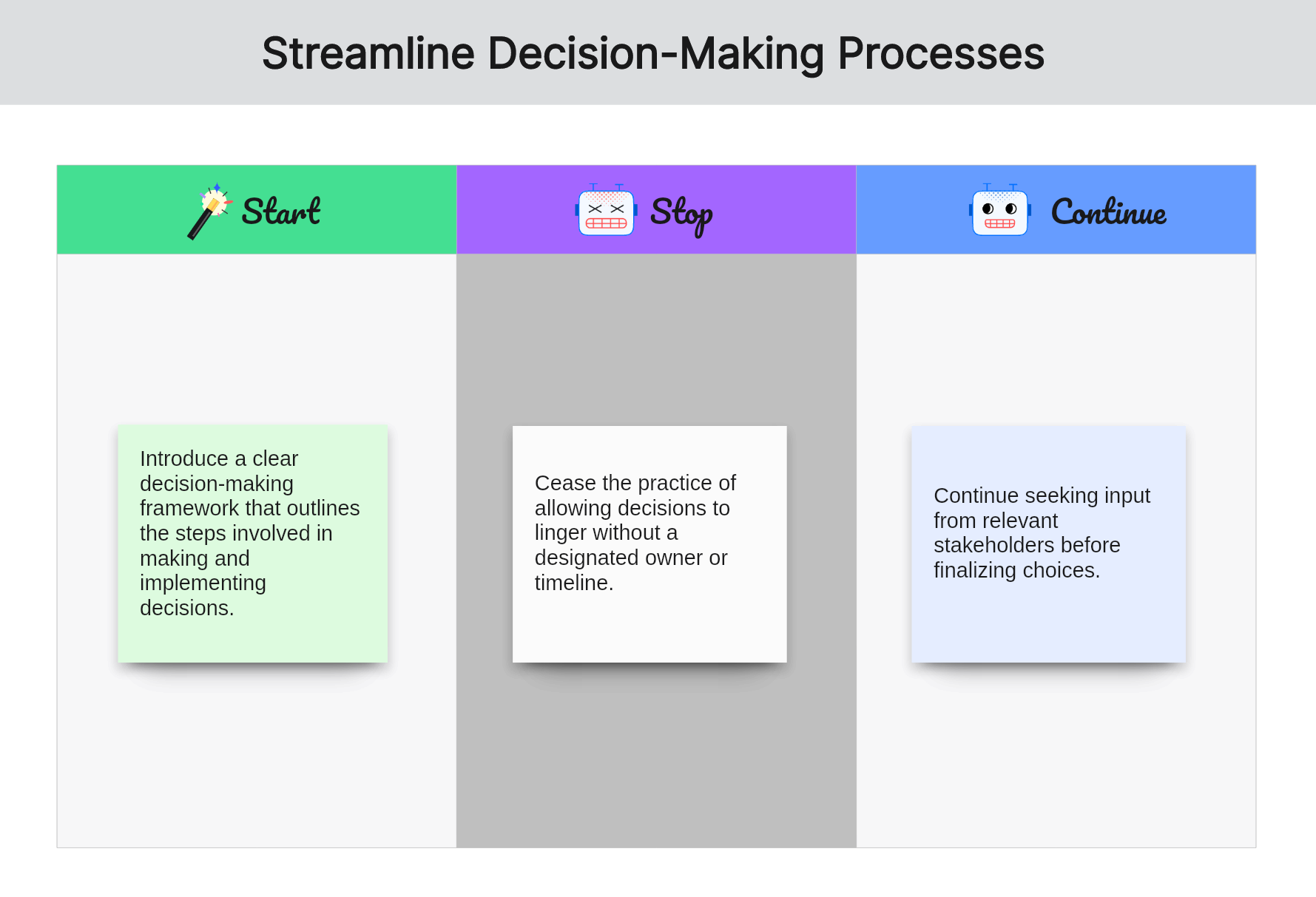
Build Start Stop Continue for Free
Start: Introduce a clear decision-making framework that outlines the steps involved in making and implementing decisions. This framework should define roles, responsibilities, and timelines, ensuring that decisions are made efficiently and with input from relevant stakeholders.
Stop: Cease the practice of allowing decisions to linger without a designated owner or timeline. This can lead to confusion, delays, and a lack of accountability. Clear ownership of decisions is essential for effective execution.
Continue: Continue seeking input from relevant stakeholders before finalizing choices. This inclusive approach ensures that diverse perspectives are considered, leading to more well-rounded and informed decisions.
Cross-Departmental Communication Start Stop Continue Template
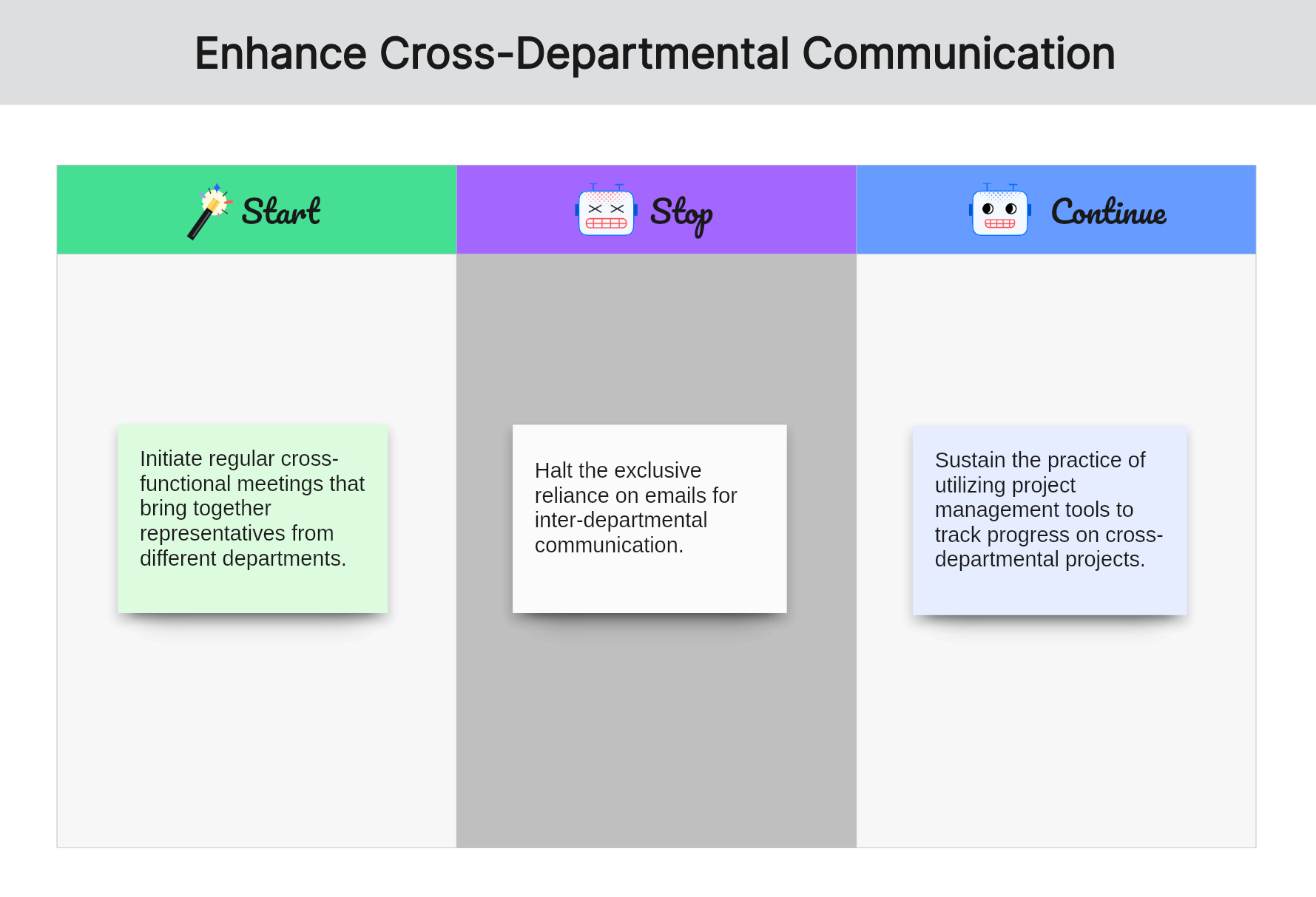
Start: Initiate regular cross-functional meetings that bring together representatives from different departments. This will create a platform for open communication, collaboration, and the sharing of insights and expertise. Such interactions can lead to more effective problem-solving and project execution.
Stop: Halt the exclusive reliance on emails for inter-departmental communication. While emails are essential, they can sometimes lead to misunderstandings or delays. Relying solely on them may hinder real-time discussions and hinder collaborative efforts.
Continue: Sustain the practice of utilizing project management tools to track progress on cross-departmental projects. These tools provide transparency and accountability, ensuring everyone is on the same page regarding timelines, milestones, and deliverables.
Project Management Start Stop Continue Template
Project teams could use it to "Start" implementing risk mitigation strategies; "Stop" redundant processes that consume unnecessary resources; and "Continue" efficient practices like regular status updates and transparent communication.
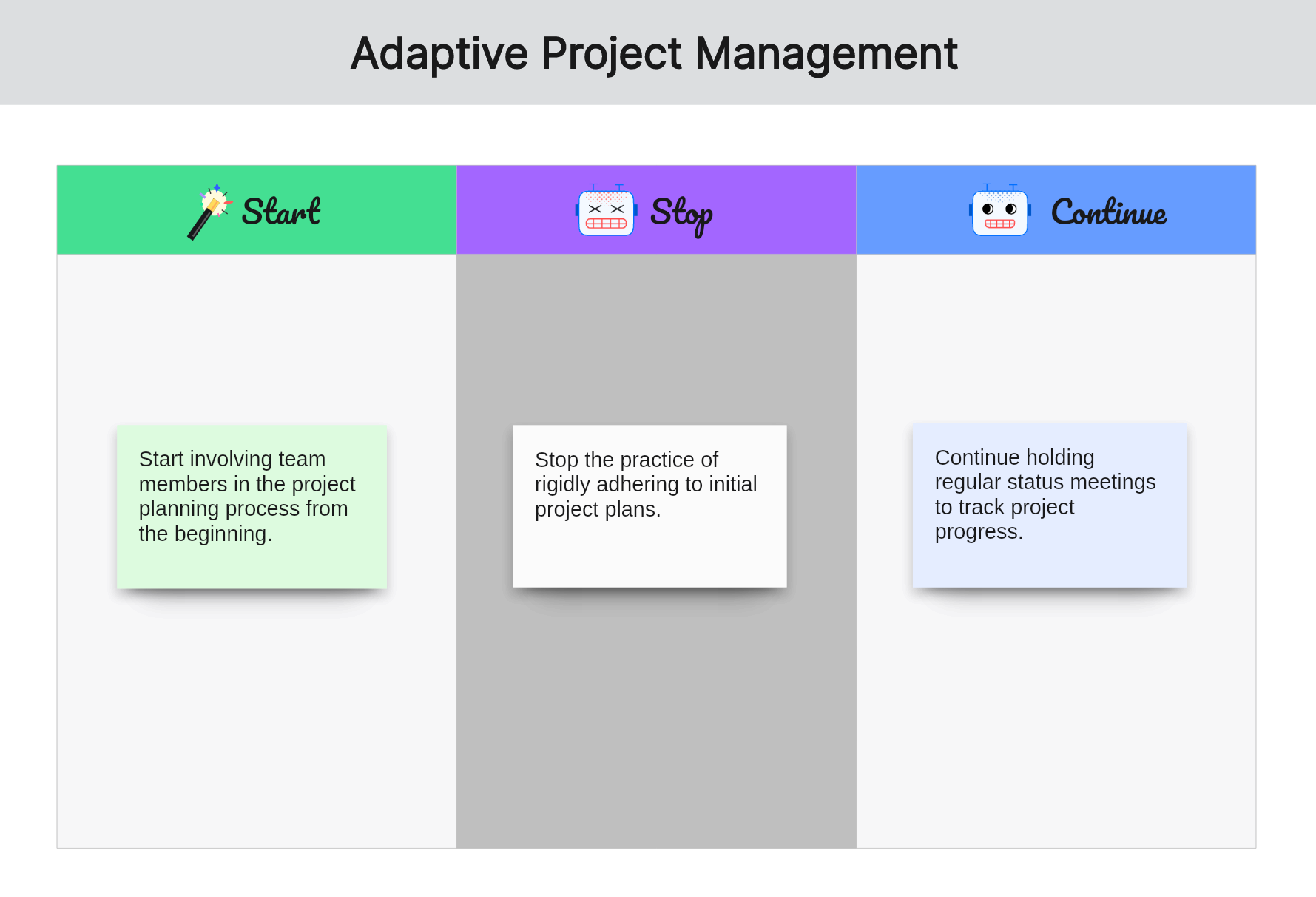
Build Start Stop Continue for Free
How to Conduct a Start Stop Continue Exercise?
Before you conduct a start stop continue exercise, you must first identify your goal for doing so. What is it that you are hoping to accomplish? When answering the three questions, you must do so with this goal always in mind.
The next step is to choose a start stop continue template to use. You can make your own as it is a fairly simple format. Just create three separate columns for start, stop, and continue. However using a template lends formality and uniformity to the process. Moreover, employing a consistent template for such analyses and maintaining them in a well-organized file streamlines progress tracking. This systematic approach simplifies monitoring the overall session evolution, providing a lucid perspective on effective strategies and areas requiring refinement.
Now, with a template ready, you and your team can fill it out while adequately discussing each item you enter into the list. Summarize the ideas and organize them into columns. Finally, you can determine what actions to implement due to the start stop continue analysis.
Meanwhile, the Start Stop Continue Feedback Template on Boardmix is a powerful tool for collecting feedback and driving improvement in any organization. This simple yet effective framework allows teams to pinpoint their strengths and identify areas where change is necessary.
Use the Start Stop Continue Template on Boardmix
1. Login or Sign Up: Navigate to the Boardmix and log in to your account. If you're new to Boardmix, you will need to create an account first.

2. Access the Template: Once logged in, navigate to the templates section and select the 'Start Stop Continue' feedback template.
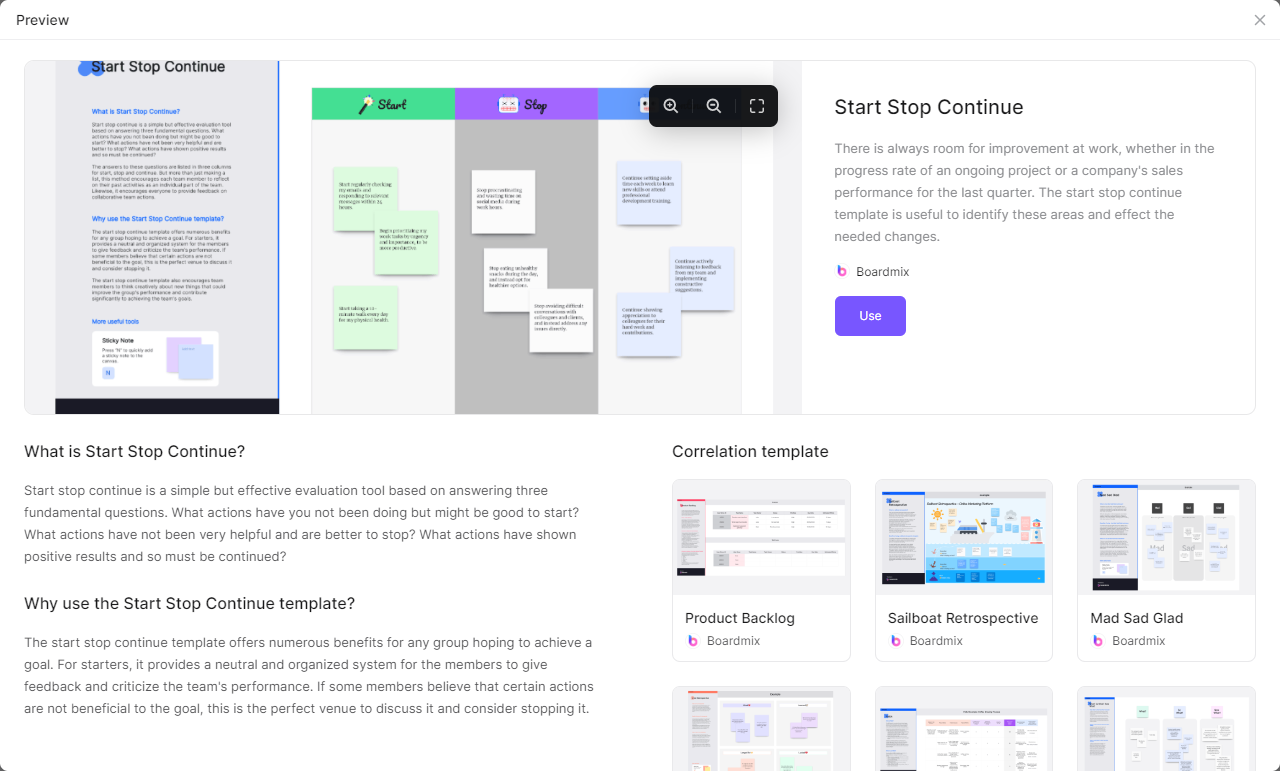
3. Begin Collating Feedback: Invite team members to start filling out the template. They can add what practices they think should be started, stopped, and continued. This could be based on their own experiences or observations about the team's overall performance.
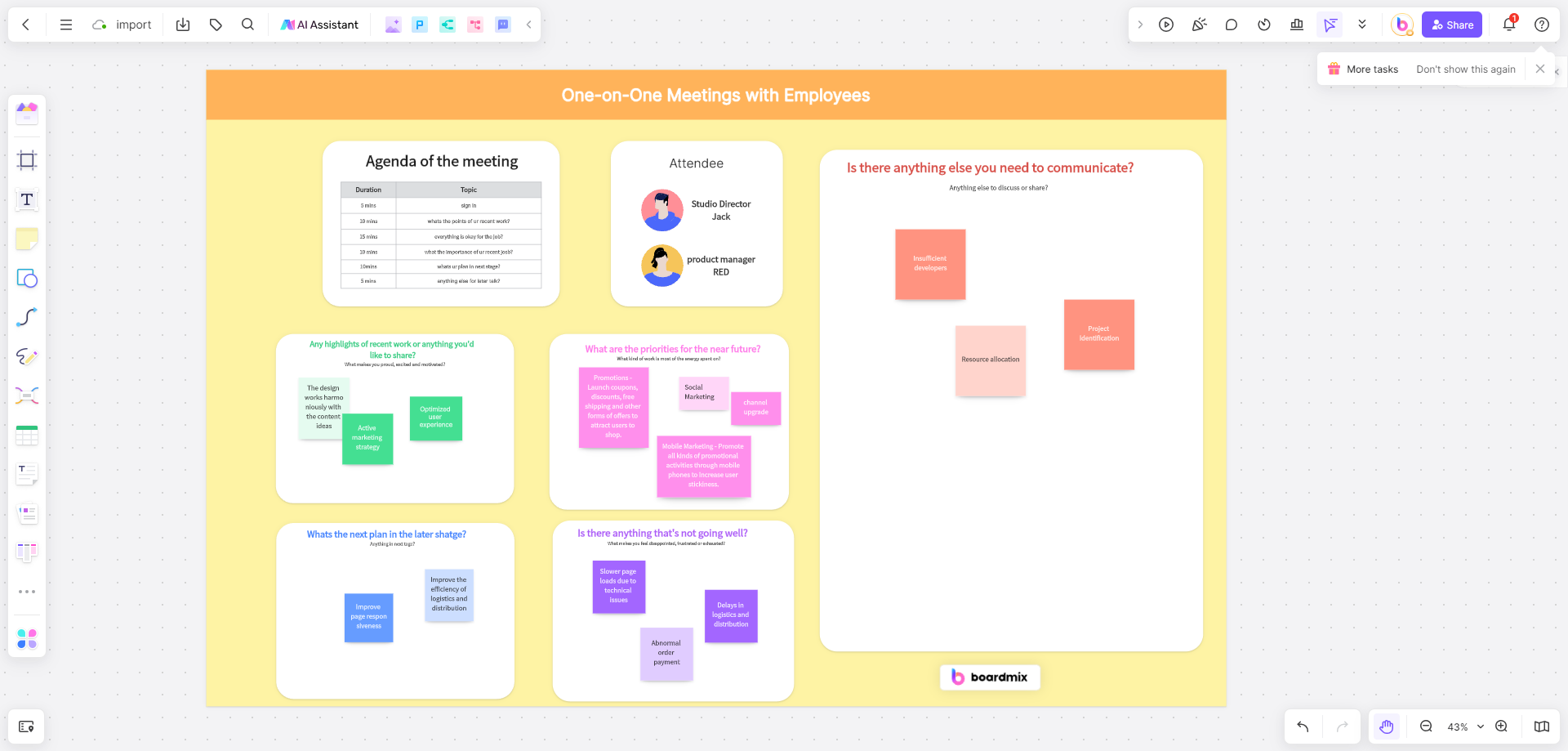
4. Review and Discuss: After everyone has had a chance to add their input, review the results as a team. Discuss each point in detail, exploring its impact, feasibility, and potential challenges.
5. Develop an Action Plan: Based on your discussion, develop an action plan. Assign responsibilities, set timelines, and determine how progress will be tracked.
6. Save and Share Your Feedback: Once your feedback collection and planning are complete, save your document for future reference or share it with others who may need it.
Tips for Maximize the Effectiveness of the Start Stop Continue
Active engagement from all participants is crucial to optimize the value derived from the start-stop continue exercise within a team or organization. Fostering an inclusive environment where every voice is heard and encouraging open dialogue for sharing feedback and suggestions becomes imperative. Such collective input ensures comprehensive insights and robust recommendations, ultimately enhancing the effectiveness of the exercise and yielding more informed decisions.
Encourage Openness: Create an environment where everyone feels safe to share their thoughts and ideas. This will foster honesty and ensure more accurate feedback.
Be Specific: Whether you're identifying actions to start, stop, or continue, be as specific as possible. Vague feedback can be hard to act on.
Prioritize: Not all actions identified will have the same impact. Prioritize those that will have the most significant effect on performance or goal achievement.
Positive Reinforcement: Recognize and appreciate the efforts made towards the actions to continue or start. This will motivate individuals to keep improving.
Use Constructive Criticism: When discussing what needs to stop, frame it as an opportunity for growth rather than a negative critique.
Make it Regular: Implementing Start Stop Continue as a regular practice (like monthly or quarterly) can help in maintaining a continuous improvement culture.
Remember, the ultimate goal of this exercise is continuous improvement, so approach it with an open mind and a commitment to act on feedback received. If you want to create the Start Stop Continue easily and efficiently, you can choose the online tool-Boadmix, and choose the suitable templates to customize your Start Stop Continue.







